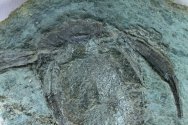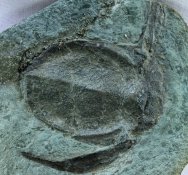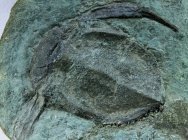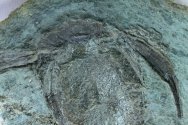Bothriolepis
canadensis
Placodermi,
Antiarcha, Bothriolepidae
Geological
Time: Upper Devonian
Size (25.4
mm = 1 inch): Body:72 mm in length and 50 mm wide with 55 mm and 27
mm fins on a 120 mm by 150 mm matrix
Fossil
Site: Escumiac Bay, Miguasha, Quebec, Canada
Fossil Code:
SRC20
Price: Sold
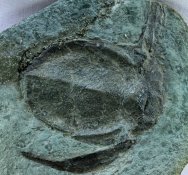 Description:
One of the most widely-recognized of all the ancient armored fishes,
this is Bothriolepis. The box-like body was enclosed in armor plates,
and provided Description:
One of the most widely-recognized of all the ancient armored fishes,
this is Bothriolepis. The box-like body was enclosed in armor plates,
and provided 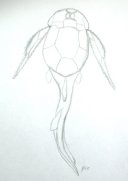 protection
from predators. Bothriolepis was the most successful of all the
placoderms, with some 100 species
known from every continent, including Antarctica. The paired holes
housed
both the eyes and the nostrils. Some specimens have been sectioned
to show the paired lung-like organs and spiral intestine, giving
a detailed view of this interesting fish. It had a long pair of
pectoral fins which would protection
from predators. Bothriolepis was the most successful of all the
placoderms, with some 100 species
known from every continent, including Antarctica. The paired holes
housed
both the eyes and the nostrils. Some specimens have been sectioned
to show the paired lung-like organs and spiral intestine, giving
a detailed view of this interesting fish. It had a long pair of
pectoral fins which would  have
helped to lift it from the bottom; its heavy body would have sunk
quickly back to the bottom as soon
as forward momentum was lost. The fins possessed spines, and an
articulation to the boxlike trunk. It is thought that Bothriolepis
grubbed in the mud of its freshwater home, and may also have used
its pectorals to stir up the mud that provided its food. Few examples
of this unusual fish are offered, and they are always received
well by collectors. This specimen displays a complete right and
a partial left pectoral fin. have
helped to lift it from the bottom; its heavy body would have sunk
quickly back to the bottom as soon
as forward momentum was lost. The fins possessed spines, and an
articulation to the boxlike trunk. It is thought that Bothriolepis
grubbed in the mud of its freshwater home, and may also have used
its pectorals to stir up the mud that provided its food. Few examples
of this unusual fish are offered, and they are always received
well by collectors. This specimen displays a complete right and
a partial left pectoral fin. |
|



